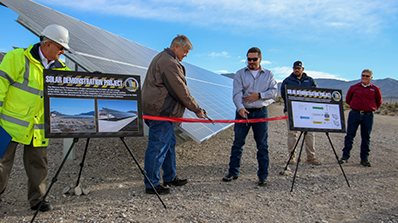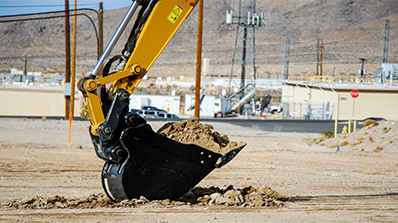The Nevada National Security Site (NNSS) has paved the way for transformation of its Mercury campus.
Site employees gathered Nov. 28 to mark the official start of construction for Building 1, the first building of a major modernization project in Mercury. The morning’s festivities also commemorated the recently installed 424-kW solar project at NNSS’ fire station No. 1, which holds the credential as the first net-zero energy building within the Department of Energy’s National Nuclear Security Administration (the Nuclear Security Enterprise). Building 1 will also be credited as a net-zero building, utilizing power produced by the new solar array.
“This Site will enable the first of several buildings that make up Mercury modernization,” said NNSS Deputy Site Director and Mission Support and Test Services* Vice President John Benner. “This is a key part of our overall strategy for modernizing the infrastructure of the Site. The design and construction of Building 1 is integral to our accelerated deployment of similar buildings out in the forward area. I want to recognize our NNSA sponsors and NFO (NNSA Nevada Field Office) for continued support of infrastructure modernization across the Site. These projects are absolutely necessary to support the Site users, our workforce and our national security missions.”
Along with building construction and solar-powered energy, the Site’s existing infrastructure will be upgraded, featuring improved underground utilities, roads, solar carports and lighted pedestrian walkways. The renovations are part of the NNSS’ effort to feature High Performance Sustainable Buildings (HPSBs) with LEED Gold and net-zero energy design criteria.

“We’re introducing modern technology in a manner that leverages existing infrastructure to the extent possible,” said NNSS Principal Project Manager Carlos Ramirez. “We’re trying to consolidate not only the buildings, but the infrastructure itself and reduce the size of what is actually needed.”
Built in the early 1950s, Mercury once saw up to 15,000 employees per day, compared to its present-day staff of 3,000. The consolidation concept began when assessing how to progress the campus environment with the NNSS’ future.
“We’ve come a long way with our plans and where we’re going,” NNSS Enterprise Infrastructure Programs Director Joel Leeman said at the event. “In a short period of time, in 2019, you’re going to be inside of a new building.”
Once preparation work is complete, construction of Building 1 is scheduled to begin in January, with employee occupancy in FY2020. The complete campus build-out, scheduled through 2028, includes eight new facilities, an Information Technology hub and future expansion buildings.
*Mission Support and Test Services serves as the management and operating contractor for the NNSS.

